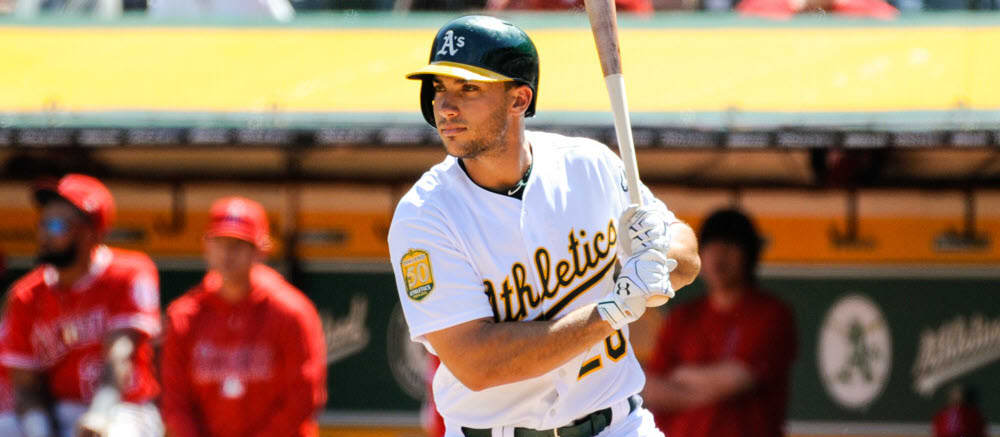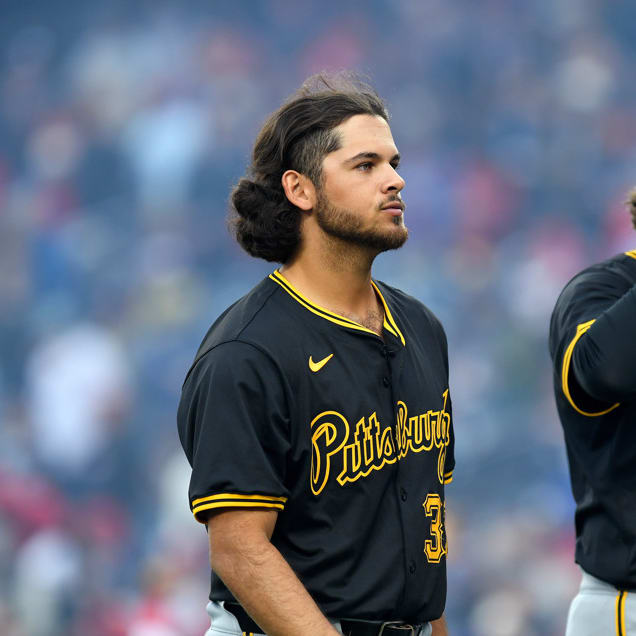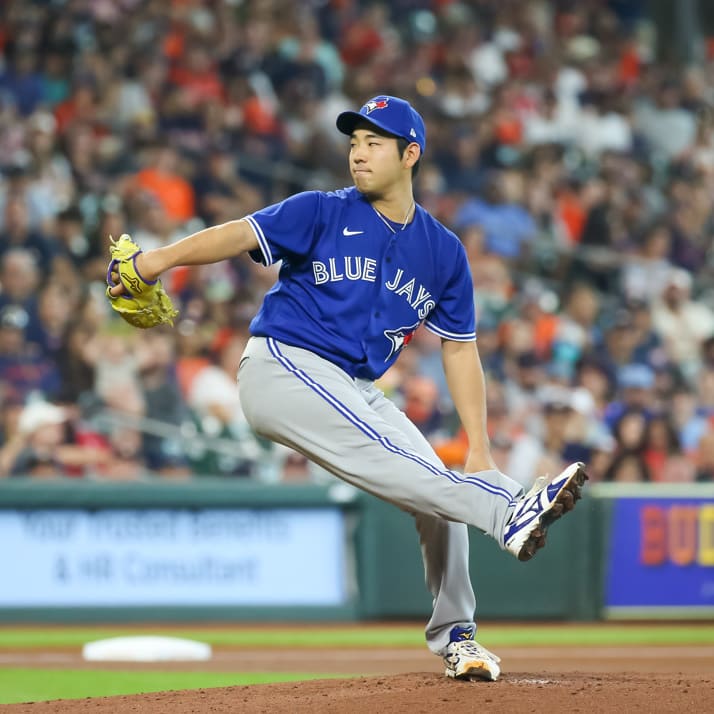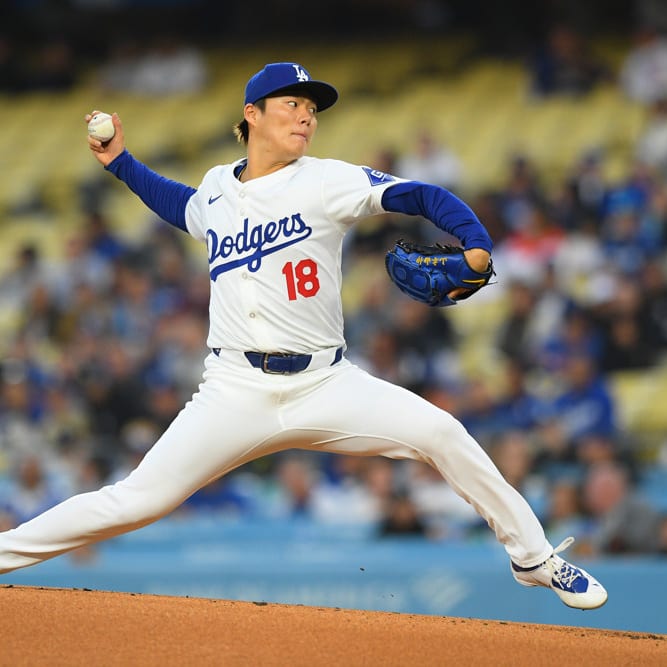This article is part of our MLB Barometer series.
Late June is a bit of an odd time on the baseball calendar. We're nowhere near the start of the season, yet we're even further from the stretch run. We're not even at the halfway point nor the All-Star break, the times at which the midseason reviews begin in earnest. We've gotten far enough into the season that it's becoming clear which of our fantasy and real-life teams have genuine potential, but it feels as though we're in a bit of a holding pattern until the next significant events on the calendar.
Aside from the All-Star break, which doesn't meaningfully impact players' fantasy outlooks, that next significant event is the start of trade season. While trades among MLB clubs won't necessarily pick up for a few more weeks, savvy fantasy owners will already be thinking about potential moves, hoping to acquire or dump a player before a change of clubs significantly impacts his value. Making such a move in anticipation of a potential change in value is, of course, quite risky, but you have to take some risks if you're looking to move from the middle to the top of the standings.
Here are some categories of players to look at if you're thinking of preempting a real-life trade with a fantasy trade of your own:
Buy starters on struggling teams with hitters' parks: A starting pitcher good enough to get traded to a contender will likely remain in the rotation and will see a boost to his win chances.
Late June is a bit of an odd time on the baseball calendar. We're nowhere near the start of the season, yet we're even further from the stretch run. We're not even at the halfway point nor the All-Star break, the times at which the midseason reviews begin in earnest. We've gotten far enough into the season that it's becoming clear which of our fantasy and real-life teams have genuine potential, but it feels as though we're in a bit of a holding pattern until the next significant events on the calendar.
Aside from the All-Star break, which doesn't meaningfully impact players' fantasy outlooks, that next significant event is the start of trade season. While trades among MLB clubs won't necessarily pick up for a few more weeks, savvy fantasy owners will already be thinking about potential moves, hoping to acquire or dump a player before a change of clubs significantly impacts his value. Making such a move in anticipation of a potential change in value is, of course, quite risky, but you have to take some risks if you're looking to move from the middle to the top of the standings.
Here are some categories of players to look at if you're thinking of preempting a real-life trade with a fantasy trade of your own:
Buy starters on struggling teams with hitters' parks: A starting pitcher good enough to get traded to a contender will likely remain in the rotation and will see a boost to his win chances. For pitchers who currently call a pitcher-friendly park home, however, the change in park factors mostly cancels out the possible extra wins. If a pitcher sees a boost in win chances and a boost in park factor, however, his value could increase significantly.
Sell closers on bad teams: Unless a reliever produces truly elite ratios (in which case he's likely already on a contender), his fantasy value comes mostly from his save chances. Many sellers trade away their closers at the deadline, but in most cases that player goes from a closer on a bad team to a setup man on a good one. There are some exceptions, but you should be looking to get out now for most pitchers in this category.
Sell low-end regulars on bad teams: These guys are typically good enough to start every game for their current clubs and good enough to attract the attention of contenders, but in most cases they'll lose playing time at most potential destinations and become a part-time player. Some contenders have such glaring holes that they'll acquire one of these guys and give him a big boost to the quality of his teammates without costing him playing time, but the default expectation for anyone in this category should be that they're at risk of losing at-bats in a few weeks.
Buy/sell expiring star hitters depending on park factors: The guys in this category are all good enough that they're at no risk of losing playing time, and they're all in line to be surrounded by better teammates. On the whole, that means most of these hitters should see at least a small boost to their value, but if they play at a particularly hitter-friendly park (like Trevor Story does), those small advantages will be covered up by park changes.
In theory, everyone in your league should have these things in mind, but many people won't adjust their evaluations of players based on merely the potential for a trade. If you're in a position where it makes sense to gamble, consider paying the first-half price for a player whose second-half value may be very different. The players who feature in the following sections of this week's barometer are guys you might consider trading away or acquiring in such a deal.
RISERS
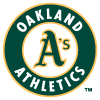 Matt Olson, 1B, Athletics: Olson has typically been good for plenty of power but with a batting average that's mediocre at best. He didn't come close to mediocre in that category last season, hitting just .195 for the year, though he did at least provide 14 homers. That poor average was at least partially attributable to a .227 BABIP, but he also struck out a career-worst 31.4 percent of the time, and it's not as if his .227 xBA was all that much better than his actual average. This season, he looks like an entirely different player in the contact department. He's cut his strikeout rate almost in half to 16.4 percent, helping him to a .305 average. He hasn't sacrificed any power to get there but has instead homered 20 times in 67 games, good for fourth in the league, a ranking that's all the more impressive considering the Athletics' pitcher-friendly home park. He's only getting better as the season has progressed, hitting .500 with five homers in his last eight games. It's very possible he moves into the top tier of first basemen during next year's drafts if he keeps up this kind of form in the second half.
Matt Olson, 1B, Athletics: Olson has typically been good for plenty of power but with a batting average that's mediocre at best. He didn't come close to mediocre in that category last season, hitting just .195 for the year, though he did at least provide 14 homers. That poor average was at least partially attributable to a .227 BABIP, but he also struck out a career-worst 31.4 percent of the time, and it's not as if his .227 xBA was all that much better than his actual average. This season, he looks like an entirely different player in the contact department. He's cut his strikeout rate almost in half to 16.4 percent, helping him to a .305 average. He hasn't sacrificed any power to get there but has instead homered 20 times in 67 games, good for fourth in the league, a ranking that's all the more impressive considering the Athletics' pitcher-friendly home park. He's only getting better as the season has progressed, hitting .500 with five homers in his last eight games. It's very possible he moves into the top tier of first basemen during next year's drafts if he keeps up this kind of form in the second half.
 Tommy Pham, OF, Padres: It wasn't hard to believe that Pham was done. After struggling to a .211/.312/.312 line during an injury-plagued 2020 campaign, he hit just .186/.314/.196 through his first 36 games this year. Given that he turned 33 in March and had been banged up, it sure looked as though Pham was playing the part of a veteran fading into a bench role at the end of his career. His turnaround over his last 34 games has been dramatic, however. He's hit .313/.436/.565 with six homers and eight steals over that stretch. Zoom in on just his last nine games and he owns an even more impressive 1.301 OPS. Taking the bad with the good leads to an overall wRC+ of 123, right in line with his career mark of 126. That's been driven primarily by a career-best 16.3 percent walk rate, as he's slugging just .396, though an expected slugging percentage of .479 indicates more could be coming in the power department. It looks as though Pham should be treated as his usual self going forward.
Tommy Pham, OF, Padres: It wasn't hard to believe that Pham was done. After struggling to a .211/.312/.312 line during an injury-plagued 2020 campaign, he hit just .186/.314/.196 through his first 36 games this year. Given that he turned 33 in March and had been banged up, it sure looked as though Pham was playing the part of a veteran fading into a bench role at the end of his career. His turnaround over his last 34 games has been dramatic, however. He's hit .313/.436/.565 with six homers and eight steals over that stretch. Zoom in on just his last nine games and he owns an even more impressive 1.301 OPS. Taking the bad with the good leads to an overall wRC+ of 123, right in line with his career mark of 126. That's been driven primarily by a career-best 16.3 percent walk rate, as he's slugging just .396, though an expected slugging percentage of .479 indicates more could be coming in the power department. It looks as though Pham should be treated as his usual self going forward.
 Zack Wheeler, SP, Phillies: Wheeler featured in this column just four weeks ago, but he earns another spot here, as he simply hasn't slowed down. Wheeler has somehow managed to completely change his profile two years in a row, yet he's gotten better each time. Through the end of the 2019 season, he rode a roughly average strikeout rate (22.8 percent) and groundball rate (46.5 percent) to a 3.77 ERA. Last year, he went from being a solid all-around starter to a low-whiff groundball specialist, with his career-high 55.9 percent groundball rate offsetting a career-low 18.4 percent strikeout rate, leading to a 2.92 ERA. He's an entirely different pitcher yet again this season, but this latest version seems to be clearly the best. His groundball rate is back down at 47.6 percent, but his strikeout rate has soared to 31.6 percent, and it's only getting higher, as he's recorded double-digit whiffs in four of his last six outings. Not only has that helped his ERA, which comes in at a career-best 2.15, it also significantly boosts his fantasy value in its own right. Wheeler sits as the sixth-best pitcher according to our earned auction values, and his 118 strikeouts (the fourth-best total in the league) are a huge part of that.
Zack Wheeler, SP, Phillies: Wheeler featured in this column just four weeks ago, but he earns another spot here, as he simply hasn't slowed down. Wheeler has somehow managed to completely change his profile two years in a row, yet he's gotten better each time. Through the end of the 2019 season, he rode a roughly average strikeout rate (22.8 percent) and groundball rate (46.5 percent) to a 3.77 ERA. Last year, he went from being a solid all-around starter to a low-whiff groundball specialist, with his career-high 55.9 percent groundball rate offsetting a career-low 18.4 percent strikeout rate, leading to a 2.92 ERA. He's an entirely different pitcher yet again this season, but this latest version seems to be clearly the best. His groundball rate is back down at 47.6 percent, but his strikeout rate has soared to 31.6 percent, and it's only getting higher, as he's recorded double-digit whiffs in four of his last six outings. Not only has that helped his ERA, which comes in at a career-best 2.15, it also significantly boosts his fantasy value in its own right. Wheeler sits as the sixth-best pitcher according to our earned auction values, and his 118 strikeouts (the fourth-best total in the league) are a huge part of that.
 Chris Paddack, SP, Padres: Paddack is still just 25 years old and has made just 51 career MLB starts, but his stock has already seen plenty of ups and downs. After striking out 34.2 percent of opposing batters and walking just 3.0 percent en route to a 1.82 ERA, he jumped straight from Double-A to the Padres' Opening Day rotation in 2019 and proceeded to cruise to a 3.33 ERA. In last year's shortened season, his strikeout rate dipped from 26.9 percent to 23.7 percent while his ERA shot up to 4.73. Through the end of April this year, he looked to be taking yet another step back, as he posted a sub-par 21.2 percent strikeout rate and a poor 5.40 ERA, but things have gone much better for him since the start of May. He's allowed more than three runs just once over that stretch, posting a 3.35 ERA while striking out 28.7 percent of opposing batters. He's been especially impressive in the strikeout department in his last two outings, whiffing a combined 20 batters. Interestingly, while his ERA had jumped around a fair amount, Paddack's xFIP (which ignores his 25.0 percent HR/FB rate last year) tells the story of a pitcher making steady improvements, as he's gone from 4.05 in his rookie season to 3.77 last year and 3.44 this season.
Chris Paddack, SP, Padres: Paddack is still just 25 years old and has made just 51 career MLB starts, but his stock has already seen plenty of ups and downs. After striking out 34.2 percent of opposing batters and walking just 3.0 percent en route to a 1.82 ERA, he jumped straight from Double-A to the Padres' Opening Day rotation in 2019 and proceeded to cruise to a 3.33 ERA. In last year's shortened season, his strikeout rate dipped from 26.9 percent to 23.7 percent while his ERA shot up to 4.73. Through the end of April this year, he looked to be taking yet another step back, as he posted a sub-par 21.2 percent strikeout rate and a poor 5.40 ERA, but things have gone much better for him since the start of May. He's allowed more than three runs just once over that stretch, posting a 3.35 ERA while striking out 28.7 percent of opposing batters. He's been especially impressive in the strikeout department in his last two outings, whiffing a combined 20 batters. Interestingly, while his ERA had jumped around a fair amount, Paddack's xFIP (which ignores his 25.0 percent HR/FB rate last year) tells the story of a pitcher making steady improvements, as he's gone from 4.05 in his rookie season to 3.77 last year and 3.44 this season.
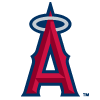 Patrick Sandoval, SP, Angels: Sandoval didn't show all that much in 76 innings over the last two seasons, though he was better than his 5.33 ERA indicated. His 22.9 percent strikeout rate and 9.5 percent walk rate were both not far from league average and, when combined with a strong 51.2 percent groundball rate, led to a 4.01 xFIP. From that perspective, his 3.69 ERA this season only looks like a modest improvement. His 53.3 percent groundball rate and 9.3 percent walk rate are both right in line with his previous numbers, but his strikeout rate now stands meaningfully improved at 24.7 percent after he struck out nine or more batters in two of his last three starts. There are reasons to believe that improvement is real, as his fastball is up from 92.8 mph last year to 93.6 mph this year, while he's also adjusted his pitch mix, cutting his slider usage by 13.6 percentage points and increasing his changeup usage by 10.9 points. It looks as though he's pitched well enough to maintain his spot in the Angels' six-man rotation, as Jose Quintana is expected to head to the bullpen upon his return from a shoulder injury.
Patrick Sandoval, SP, Angels: Sandoval didn't show all that much in 76 innings over the last two seasons, though he was better than his 5.33 ERA indicated. His 22.9 percent strikeout rate and 9.5 percent walk rate were both not far from league average and, when combined with a strong 51.2 percent groundball rate, led to a 4.01 xFIP. From that perspective, his 3.69 ERA this season only looks like a modest improvement. His 53.3 percent groundball rate and 9.3 percent walk rate are both right in line with his previous numbers, but his strikeout rate now stands meaningfully improved at 24.7 percent after he struck out nine or more batters in two of his last three starts. There are reasons to believe that improvement is real, as his fastball is up from 92.8 mph last year to 93.6 mph this year, while he's also adjusted his pitch mix, cutting his slider usage by 13.6 percentage points and increasing his changeup usage by 10.9 points. It looks as though he's pitched well enough to maintain his spot in the Angels' six-man rotation, as Jose Quintana is expected to head to the bullpen upon his return from a shoulder injury.
FALLERS
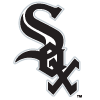 Yermin Mercedes, DH, White Sox: It was fun while it lasted. Mercedes went 5-for-5 in his season debut, hit .500 through his first 10 games and hit .364/.414/.557 through his first 40. It was a remarkable start to the season for a 28-year-old who had precisely one MLB plate appearance to his name heading into the year. He's spent the last 25 games demonstrating exactly why he'd yet to establish himself. His .112/.175/.157 line over that stretch means he now has a barely above-average 102 wRC+ on the year. For a player who offers no defensive value whatsoever, that's simply not good enough. The White Sox seemingly agree, as Mercedes has found himself on the bench more regularly in recent weeks, starting just five of the team's last eight games. Mercedes' 7.1 percent barrel rate and 29.3 percent hard-hit rate on the season are both below average, and between that and his lack of any previous MLB track record, it's hard to buy into a return to early-season form.
Yermin Mercedes, DH, White Sox: It was fun while it lasted. Mercedes went 5-for-5 in his season debut, hit .500 through his first 10 games and hit .364/.414/.557 through his first 40. It was a remarkable start to the season for a 28-year-old who had precisely one MLB plate appearance to his name heading into the year. He's spent the last 25 games demonstrating exactly why he'd yet to establish himself. His .112/.175/.157 line over that stretch means he now has a barely above-average 102 wRC+ on the year. For a player who offers no defensive value whatsoever, that's simply not good enough. The White Sox seemingly agree, as Mercedes has found himself on the bench more regularly in recent weeks, starting just five of the team's last eight games. Mercedes' 7.1 percent barrel rate and 29.3 percent hard-hit rate on the season are both below average, and between that and his lack of any previous MLB track record, it's hard to buy into a return to early-season form.
 Eric Hosmer, 1B, Padres: The eight-year, $144 million contract the Padres handed Hosmer prior to the 2019 season was an odd one given the team's reputation as a smart, analytically minded organization and Hosmer's reputation as a player whose pedigree was generally not supported by analytics. Of course, there'd long been a thought that Hosmer had another gear to reach if he could just start hitting the ball in the air more often, and that happened in last year's shortened season. His personal Statcast-era high launch angle of 8.7 degrees led to a career-best .517 slugging percentage. Unfortunately, those gains have entirely evaporated this season. His launch angle has cratered to 2.8 degrees, taking a huge bite out of his overall performance with it, as he's hitting just .249/.308/.357 with six homers in 66 games. Things are only getting worse for him as the season has progressed, as he's hit a miserable .141/.191/.203 thus far in June. At this point, a return to his mediocre pre-2020 form seems to be about the best that can be hoped for.
Eric Hosmer, 1B, Padres: The eight-year, $144 million contract the Padres handed Hosmer prior to the 2019 season was an odd one given the team's reputation as a smart, analytically minded organization and Hosmer's reputation as a player whose pedigree was generally not supported by analytics. Of course, there'd long been a thought that Hosmer had another gear to reach if he could just start hitting the ball in the air more often, and that happened in last year's shortened season. His personal Statcast-era high launch angle of 8.7 degrees led to a career-best .517 slugging percentage. Unfortunately, those gains have entirely evaporated this season. His launch angle has cratered to 2.8 degrees, taking a huge bite out of his overall performance with it, as he's hitting just .249/.308/.357 with six homers in 66 games. Things are only getting worse for him as the season has progressed, as he's hit a miserable .141/.191/.203 thus far in June. At this point, a return to his mediocre pre-2020 form seems to be about the best that can be hoped for.
 Hyun Jin Ryu, SP, Blue Jays: Ryu has traditionally been a pitcher who gets a slightly below-average amount of strikeouts, relying on low walk rates and above-average groundball rates to keep runs off the board. He's occasionally flashed at least modest strikeout upside, however, including last season, when he finished with a 26.2 percent strikeout rate to go along with his 2.69 ERA. Through the first two months of this season, he looked set for a fairly similar year, striking out 25.0 percent of opposing batters while cruising to a 2.62 ERA. Things changed suddenly once the calendar flipped to June, however, as he's struck out just 11.0 percent of batters for the month and never more than four in a given start after whiffing at least five in nine of his first 10 outings. Even after allowing just one run against the Orioles on Sunday (despite striking out just four batters), he owns a 4.74 ERA for the month and a considerably worse 6.53 FIP. He hasn't seen a velocity dip, so it's possible he remembers how to strike out people soon, but it's certainly worrisome to see a 34-year-old lose such a dramatic amount of whiffs in such a short span.
Hyun Jin Ryu, SP, Blue Jays: Ryu has traditionally been a pitcher who gets a slightly below-average amount of strikeouts, relying on low walk rates and above-average groundball rates to keep runs off the board. He's occasionally flashed at least modest strikeout upside, however, including last season, when he finished with a 26.2 percent strikeout rate to go along with his 2.69 ERA. Through the first two months of this season, he looked set for a fairly similar year, striking out 25.0 percent of opposing batters while cruising to a 2.62 ERA. Things changed suddenly once the calendar flipped to June, however, as he's struck out just 11.0 percent of batters for the month and never more than four in a given start after whiffing at least five in nine of his first 10 outings. Even after allowing just one run against the Orioles on Sunday (despite striking out just four batters), he owns a 4.74 ERA for the month and a considerably worse 6.53 FIP. He hasn't seen a velocity dip, so it's possible he remembers how to strike out people soon, but it's certainly worrisome to see a 34-year-old lose such a dramatic amount of whiffs in such a short span.
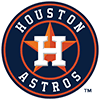 Zack Greinke, RP, Astros: If veteran pitchers with declining strikeout rates like Ryu scare you, you won't like the look of Greinke's recent lines, either. Like Ryu, Greinke has typically been much better at avoiding walks than generating whiffs, though he did manage to strike out an above-average 24.5 percent of opposing batters last year. Unlike Ryu, his strikeout rate had already started to drop over the first two months of the season, coming in at just 20.0 percent, but it's fallen off a cliff in June, sitting at 13.0 percent through four starts. He actually managed to allow just two runs in 17 innings in the first two of those starts despite striking out just seven total batters, but he's since gone on to allow seven runs in 8.2 frames in his last two trips to the mound. This is far from definitively the end for the 37-year-old righty, who's found ways to be successful despite diminished stuff in the past, but it might be tough for him to provide value in line with his draft-day stock going forward. If you bought in expecting strong ratios and an acceptable strikeout rate, you could be stuck with merely acceptable ratios while he actively hurts you in the strikeout category.
Zack Greinke, RP, Astros: If veteran pitchers with declining strikeout rates like Ryu scare you, you won't like the look of Greinke's recent lines, either. Like Ryu, Greinke has typically been much better at avoiding walks than generating whiffs, though he did manage to strike out an above-average 24.5 percent of opposing batters last year. Unlike Ryu, his strikeout rate had already started to drop over the first two months of the season, coming in at just 20.0 percent, but it's fallen off a cliff in June, sitting at 13.0 percent through four starts. He actually managed to allow just two runs in 17 innings in the first two of those starts despite striking out just seven total batters, but he's since gone on to allow seven runs in 8.2 frames in his last two trips to the mound. This is far from definitively the end for the 37-year-old righty, who's found ways to be successful despite diminished stuff in the past, but it might be tough for him to provide value in line with his draft-day stock going forward. If you bought in expecting strong ratios and an acceptable strikeout rate, you could be stuck with merely acceptable ratios while he actively hurts you in the strikeout category.
 Brandon Lowe, 2B/OF, Rays: The Rays' genius seems to stem from their ability to get the most out of a group of flawed players, mixing and matching a number of interchangeable pieces to create one of the best rosters in the league despite relative lack of top-end talent compared to most contenders. Lowe is one of those flawed players, as he has severe platoon splits, hitting just .195/.262/.420 lifetime against lefties, and a significant strikeout problem, whiffing at a 30.4 percent clip for his career. His strengths, most notably his considerable power for a middle infielder, have generally outweighed his flaws so far in his career, helping him go as the fifth second baseman across the board in NFBC drafts over the winter, but the opposite has largely been true this season. He does have a respectable 13 homers, but his .202 batting average has suppressed his overall value, making him merely the 14th-best player at the position per our earned auction values. His 31.8 percent strikeout rate is the primary problem, and while he's had some better luck at the plate over his last 10 games, posting a .971 OPS, he's still striking out 34.2 percent of the time over that stretch. Wander Franco's promotion on Tuesday will send waves throughout the Rays' roster, and Lowe's mediocre performances all year means he'll likely be one of the players who loses playing time to accommodate the highly touted rookie.
Brandon Lowe, 2B/OF, Rays: The Rays' genius seems to stem from their ability to get the most out of a group of flawed players, mixing and matching a number of interchangeable pieces to create one of the best rosters in the league despite relative lack of top-end talent compared to most contenders. Lowe is one of those flawed players, as he has severe platoon splits, hitting just .195/.262/.420 lifetime against lefties, and a significant strikeout problem, whiffing at a 30.4 percent clip for his career. His strengths, most notably his considerable power for a middle infielder, have generally outweighed his flaws so far in his career, helping him go as the fifth second baseman across the board in NFBC drafts over the winter, but the opposite has largely been true this season. He does have a respectable 13 homers, but his .202 batting average has suppressed his overall value, making him merely the 14th-best player at the position per our earned auction values. His 31.8 percent strikeout rate is the primary problem, and while he's had some better luck at the plate over his last 10 games, posting a .971 OPS, he's still striking out 34.2 percent of the time over that stretch. Wander Franco's promotion on Tuesday will send waves throughout the Rays' roster, and Lowe's mediocre performances all year means he'll likely be one of the players who loses playing time to accommodate the highly touted rookie.

